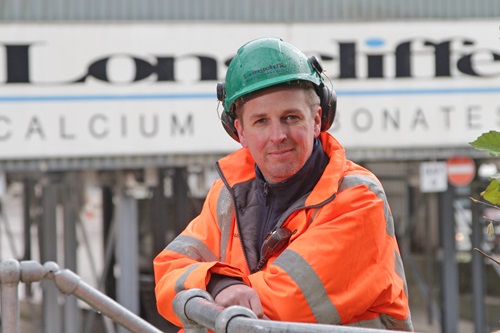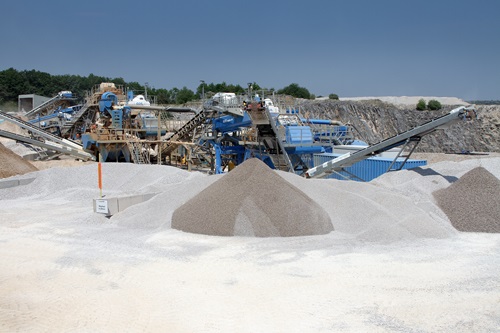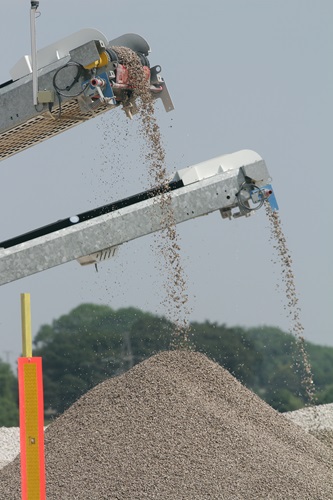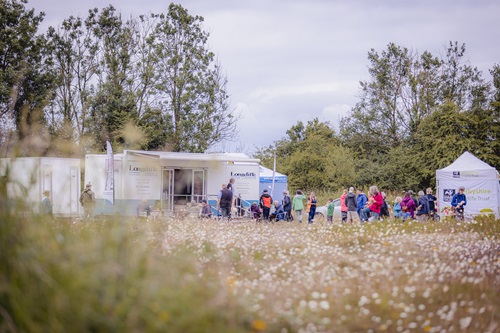
Longcliffe Quarries is gearing up for sustainability-minded growth across its diverse product portfolio. Guy Woodford visited the Derbyshire, England-based company for a fascinating tour and wide-ranging conversation with the management team at the longstanding independent and still family-owned business.
At a viewing point high above Longcliffe Quarries' Brassington Moor Quarry (Brassington Moor) near Ashbourne, Jon Murgatroyd, the quarry manager, is talking to me about the site's production process.
"We drill and blast to extract four different types of stone. A contract crusher takes the material from the upper benches and makes it into road stone for us. We have one [Epiroc FlexiROC D55] drill rig here and another at our Ryder Point Quarry. Our in-house drill and blast team alternates via an access road between the quarries. Ryder Point is a [dolomitic limestone] aggregates quarry about a mile-and-a-half to two miles away. We use EPC-UK commercial explosives at both sites."

Murgatroyd and I are joined by Paul Boustead, Longcliffe Group's managing director, Ian McDonald, Longcliffe Quarries' development director (process), and Chris Wainwright, the company's operations director.
"Having our own in-house drill and blast team gives us flexibility when blending [extracted material] chemistry and enables us to react to customer needs," explains Boustead.
McDonald adds: "We're slightly unusual in that our blast sizes are not as big as they should be for economic reasons. Because we might leave the piles down longer than you would normally do, we can dry scalp and reclaim a lot more stone in the first pass. If you move and fire a shot within two days, it's not a problem, but Jon will have a high-quality shot down for a week, and you use the resulting material as you need it. What Jon crushes today is sold by tomorrow. We haven't got the on-site storage capability to store a week's worth of crushed material."
"It's little and often blasting," says Murgatroyd. "We're doing eight to ten holes, not the big 20-hole shots. We use Varistem stemming plugs. We were one of their first customers in Europe. Using their plugs has reduced our blasting costs and given us better blasting fragmentation.

"At any one time, we can have up to ten shots down to mix and match the chemistry. As soon as they drill the shot, they take haul samples to our lab and run them through a spectrum analyser to give us an idea of what material we will get before we get it."
Murgatroyd continues to explain Brassington Moor's production process. "We have two excavators, a Liebherr 972 and a Cat 390, feeding three [Terex Trucks] TR70 dump trucks. This means I can blend stones from different parts of the quarry to try and mix their levels. This mixed stone is fed into a Metso Nordberg C160 jaw crusher. From there, it goes into an MMD [Group mineral] sizer. That leaves the sizer with 300mm down products. This is conveyed into the screen house and over a roll screen, and the feed is split into a large or small fraction. In the screen house are some reversible belts; depending on what chemistry we want in the final product, half of it will go to the secondary crusher and the other half to the feeders. The feeders have a tunnel underneath them. We get enough stone on them to run production through the night. We work 11-hour weekday shifts plus Saturday mornings with the primary crusher. We fill the silos and the feeder throughout the daytime, and then the night shift can draw off the feeders and refill the silos to keep them running throughout the night.

"After the secondary crushing process, we are filling out three big silos. One contains pure white, clean, clay-free stone that feeds the aggregate plant, and another feeds the Pyro plant for industrial and chemical mineral products. The third silo feeds an Ambuco plant that is producing products for glass-making factories and animal feeds. We also have an attritor [mill] plant, which recycles excess material from the other two industrial mineral plants."
"We have 30 powder tankers and ten tipper trucks and supply the four corners of the UK from here," notes Boustead. "With the recent changes to BS 8500 [UK concrete standards], with limestone fillers replacing OPC [ordinary Portland cement], we can see our [Brassington Moor] business growing and growing."
Longcliffe Quarries has just agreed to buy another 15 Volvo HGV tractor units. "The emission reductions and the attractive miles per gallon they give you have led to this new investment," explains Boustead, who became Longcliffe Quarries group managing director in 2022. "We've demonstrated that in a fully laden 44-tonne articulated lorry, we can get 10.5 miles to the gallon. That's class-leading. Investing in the best technology exemplifies Longcliffe's commitment to its customers.
"Having mainly our own haulage fleet, supplemented with local hauliers, gives us a business advantage. A sub-contractor haulier may say, 'I'm not delivering those loads over that distance,' but we will do so at the right price. Within 48 hours of placing an [industrial minerals product] order, we like to deliver it to the customer. Many of our aggregate customers collect their orders, with others delivered by us the next day. In the short time, I've been here, we've built on the 'customer first' approach and focused on how we can make their [working] lives easy."

Has Longcliffe Quarries supplied materials for current or recently completed UK infrastructure projects? "At the start of the HS2, we supplied MOT Type 1 and 6F5. It was during COVID-19, and some major sites had shut down, but we could still meet orders. Due to the nature of our supply into critical industrial mineral processes, we could still supply as we had to remain operational," says Boustead. "We also supply many industrial products for civil engineering contractors working on projects across the Midlands."
McDonald adds that the stone that built the visitor centre at The National Stone Centre in nearby Wirksworth came from Longcliffe Quarries.
Turning to the extensive ongoing work to create rollover slopes to improve the appearance of old quarried areas of Brassington Moor, Boustead says: "We use a wildflower mix on the rollover slopes, creating a meadow that encourages insects and other wildlife. With Longcliffe Quarries and some other local quarry operators' success in creating rollover slopes, the landscape architect for Derbyshire [local authorities], who is also involved with the Peak District, has acknowledged that they meet its [restoration] standard and are great examples of this particular type of restoration. We are proud of that, and our restoration work is fundamental to our plans for extended quarry extraction at Brassington Moor. Indeed, the minimum now set down in new quarry planning applications is a 10% biodiversity net gain. Our calculations for the sympathetic restoration of the proposed new Aldwark South area result in just under 14% biodiversity improvement.
"We have two ex-worked quarries, Peak and Hoe Grange, and have partnered with Derbyshire Wildlife Trust and Butterfly Conservation East Midlands to manage them sympathetically from a biodiversity perspective. Hoe Grange hosts a 'Butterfly Day' once a year, which attracts up to 450 people." Volunteers from Butterfly Conservation Trust have been walking a weekly transect at Hoe Grange for a few years, recording 29 different butterfly species. Butterflies recorded include the Small Skipper, Large White, Small White, Green-Veined White, Orange Tip, and Small Copper. "More than 50% of the UK's butterfly species have been seen at Hoe Grange," adds Wainwright. McDonald notes that peregrine falcons have successfully bred at Brassington Moor and Ryder Point nearly every year over the last 30 years.
Murgratroyd drives us from our Brassington Moor viewing platform to the quarry's state-of-the-art CDE plant for a close-up look.
In 2019, Longcliffe Quarries partnered with the major global market manufacturer of wet processing technologies to tackle the high volume of waste generated at Brassington Moor. The business had traditionally discarded its quarry by-product, a material with a higher clay content. However, feasibility studies and material testing to demonstrate market demand for products recovered from this stream showcased the potential for Longcliffe Quarries to realise its commercial targets without sacrificing its sustainability imperatives.

Installed in 2020 during the height of the COVID-19 pandemic, the only installation undertaken by CDE during the pandemic due to Longcliffe Quarries' need to fulfil its major customer product supply commitments, the £3.5 million, 220 tonnes-per-hour CDE state-of-the-art wet processing plant is the single largest investment Longcliffe Quarries has ever made.
Engineered to maximise product yield from heavy clay-bound feedstock, the bespoke plant features CDE's signature AggMax modular logwasher setup for scrubbing and sizing. It also incorporates CDE's patented EvoWash classification and dewatering system, which offers greater efficiency than traditional washing methods.
Central to the system and to address the availability of clean water on site is CDE's AquaCycle thickener, which allows for up to 90% of the process water to be recycled and recirculated back into the system, offering near-total independence from freshwater supplies. Exceptional water management means the CDE wash plant requires only a small top-up water supply, resulting in a highly efficient system that extends significant operational savings to Longcliffe Quarries.

Previously discarded clay-bound material is now being processed through the wet processing plant, creating new, high-value revenue streams. High-quality single-sized aggregates and sand grades are among the key recovered products, maximising available reserves and supporting Longcliffe Quarries to realise its environmental targets.
The CDE plant features CDE CORE, a suite of smart technology tools that offers plant operators greater control over their plant and access to real-time data on how it operates to maximise plant uptime and throughput.
On arrival at the plant, I asked how it has performed since installation. "It is a very good wash plant that washes our harshest material. Waste-wise, it's also made a big difference," stresses McDonald. "It's changed the whole structure of how the quarry works. Before, we would be trying to determine how big our landforms needed to be to put your waste in. A lot of your quarry plan design included areas to keep waste. Now you only design in lagoons. We're down to only about 11% wastage from 25-30%."
Murgatroyd adds: "We're hoping that after I've put the next lagoon in, there can be a fixed point for dewatering for a few years rather than weeks. We've been looking at how we will get power to that fixed point."
Brassington Moor, which includes two further extensive mineral extraction areas known as Pyro and Aldwark, produces 1.4 million tonnes of calcium carbonate powders and granules annually. As highlighted during my quarry tour, calcium carbonate forms the basis of many everyday products, such as animal feed, pet foods, drinking glasses, plastics, and pharmaceuticals. In addition to Brassington Moor's output, Ryder Point produces up to 500,000 tonnes a year of high-quality dolomitic limestone aggregate.
With a turnover of £50 million a year, Longcliffe Quarries produces 106 products for various industries. Two-thirds of production is dedicated to industrial minerals and a third to aggregates.
As we continue our Brassington Moor tour, I learn that 92% of Longcliffe Quarries' 192 employees live within 20 miles of the business, with over 80% living within 10 miles. Many employees take part in the company's cycle-to-work scheme. Longcliffe Quarries is looking to take on another five apprentices this year after what Boustead says had been the "great success" of its previous apprentice intakes.

I ask Boustead how difficult it is to attract young apprentice talent to the business. "We are competing with the likes of Amazon and the general warehouse work environment. The beauty of our industry, and Longcliffe Quarries in particular, is that you may join us as an MPQC [Mineral Products Qualifications Council]- supported electrical engineer, but you aren't wedded to that role for your career. However you enter the business, this can lead to a vast array of careers in our industry. We partner with a college in Stoke, are getting closer to Derby College, and do some work with the University of Derby.
"We are attracting more apprentice applicants now because of the breadth of where the apprenticeship can lead you. I think we've got 12 who have their NVQ Level 6. We lost one of our apprentices when he finished his apprenticeship. He went to work at one of those warehouse jobs, and three weeks later, he rang up and asked if he could come back. He said the pay may have been a bit more, but he hated his working conditions and a work culture that made him feel like a number. He said he wanted to return to our 'family' culture.
"We have brilliant employee service, with some of our team having been here 30 years plus. Gerald Lees celebrated his 50th work anniversary here in 2018. He's still one of my best excavator operators. However, in the next four to five years, we will probably lose around 40% of the workforce to retirement, so we are succession planning."

On our return to Longcliffe Quarries' head office, around a mile from the Brassington Moor Quarry Complex, via the impressive Curzon Lodge Transport Garage and Hoe Grange, Boustead highlights more of the company's extensive sustainability-enhancing projects. "We are targeting net zero to weighbridge by 2030, reducing electricity usage, and increasing renewable carbon-neutral energy sources, working with National Grid to direct more wind farm power to Longcliffe operations. The head office is solar-powered, and we plan to install solar panels at our transport depot."
An example of Longcliffe Quarries' continuous investment in its business and part of a £3 million project to enhance its Brassington Moor Pyro plant production, two new energy-efficient TCM mills will be installed in the second half of 2024.
McDonald says: "The recycling of our materials has been quite inefficient. We bought the first of our two existing attritor mills in the 1990s and the other in 2008. They have built up slowly to 100% capacity. The problem has been that they produce what are classified as two products when the market just wants one. This creates a big inefficiency. The new TCM mills will be more efficient with a single-pass-through and classifier, making one product at a time. You cut out another big inefficiency because the classifier is in the milling process. The new mills will not be so maintenance-heavy and help avoid major failures that could stop production for up to a week.

"Over 20% of our calcium carbonate powder and granule sales are L150 cementitious replacement-type material. It is a growing market, but we only have 300 tonnes of storage for this particular product on-site. The two new mills will give us another 350 tonnes of storage to help schedule our delivery lorries."
Established in 1927, Longcliffe Quarries is still owned by the Shields family. Current company chairman Robert Shields' great-grandfather started the business. Two of Robert's sons, John and David, also have roles in the business. John is Longcliffe Quarries' energy director, leading the company's sustainability agenda, and David sits on the management board.
Boustead says another example of Longcliffe Quarries' family feel is the recent launch of Longcliffe Choices. "It's a web portal where the team can get shopping vouchers and employee discounts. It also has their day-to-day work information, pension details, and wage slips. When the cost-of-living crisis hit, we helped staff not just with remuneration but also food shopping vouchers to support them during this difficult time. The team were appreciative."
An exhibition held in March 2023 as part of Longcliffe Quarries' public consultation on its Aldwark South extension plans highlighted how the company contributes around £20 million yearly to the local economy through wages and using local contractors.
Furthermore, Longcliffe Community Fund allocates more than £70,000 yearly to local projects. These have included taking a team and a Longcliffe lorry to Anthony Gell School in Wirksworth to educate pupils about road safety as part of National Road Safety Week and a £3,000 donation to Cromford Church of England Primary School to help pay for a significant school playground makeover.
The exhibition noted that Aldwark South is already identified in the Draft Mineral Local Plan as a future source of high-purity limestone. Ig the planning application is successful, the quarry extension will secure Longcliffe Quarries' future and protect many jobs.
"The main growth driver for our business is being able to offer our new innovative industrial mineral solutions and products," emphasises Boustead. "From a high-purity resource point of view, which is our core business, we have identified medium- and long-term reserves, but this depends on a successful planning application. We have just submitted our formal planning application for Aldwark South. If successful, it will allow us to tap into another 27 years of high-purity industrial mineral reserves."













